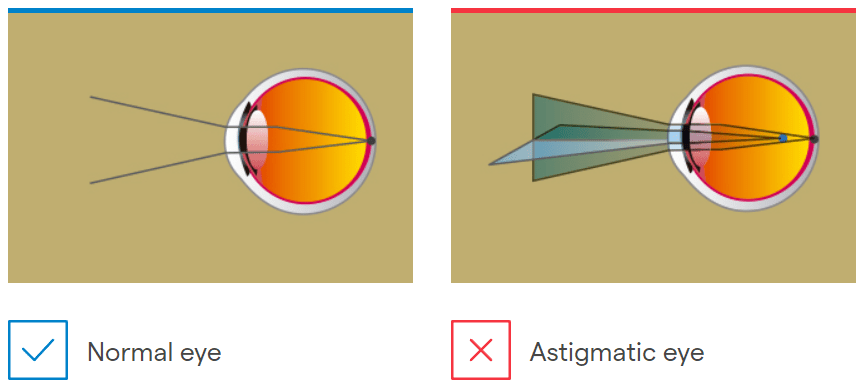What is astigmatism?

- Astigmatism is a refractive defect that causes images to focus on the retina in a distorted way
- It affects near and far visio
- It can occur by itself or in association with myopia or hyperopia
- It is usually stable throughout life.
What causes it?
- It is usually caused by a problem in the curvature of the cornea that impedes clear focusing on near and far objects
- The cornea loses its spherical shape, becoming elliptical
- Furthermore, the cause of this irregularity can be:
- Hereditary
- it may also occur as a result of trauma or disease
- It may also appear after surgical procedures
How can it be prevented?
Astigmatism cannot be prevented.
It can be diagnosed through an ophthalmological examination.
The most common tests include:
- a refraction test
- a corneal topography (if needed)
Certain special or complex cases may require other types of test.
Symptoms

They can vary depending on age and type and degree of astigmatism.
The most common symptoms are:
- Perception of distorted images (most common symptom).
- Poor visual acuity in far vision.
- Problems in switching between near and far vision.
- Difficulties in seeing fine detail, either near or distant.
- Headaches, eye pain or dizziness, as a result of the eye’s muscular effort in trying to compensate for the defect with the accommodation of the crystalline lens (the eye’s natural lens whose elasticity enables the eye to focus). This is especially true in cases of astigmatism associated with hyperopia.
Astigmatism can cause discomfort (headaches or dizziness)
If the astigmatism is low, it may not affect vision.
Associated treatments
Astigmatism can be corrected by glasses or toric contact lens.
Surgical treatment
If the patient prefers not to wear glasses or contact lenses, surgical solutions are available. Refractive surgery includes several techniques depending on the diagnosis:
Excimer laser: applied to the thickness of the cornea, used to correct moderate astigmatism. Femtosecond laser is often used during laser refractive procedures.
Incisional technique. (Arcuate keratotomy): consisting of making incisions on the corneal surface, indicated for high astigmatism.
Toric intraocular lenses: phakic (implanted between the cornea and crystalline lens) and pseudophakic (replacing the crystalline lens). It is commonly used to correct high astigmatism
The ophthalmologist will determine the most appropriate technique for each case.
About 80% of success in surgery depends on: proper diagnosis and the selection of the type of surgery to use.
Specialists who treat this pathology
FAQs
For the first two weeks, in particular, the patient should avoid rubbing the eyes, going swimming in a public pool and using eyelid make-up.
The patient can generally have acceptable or near-maximum vision within a few hours. Occasionally, however, it can take up to a week for vision to improve.
Yes, as can all post-operative patients, irrespective of the pathology, provided that their physical condition permits and several days have passed since the operation.
Nowadays, there are several techniques. The most popular for small refractive errors, such as myopia, hyperopia and astigmatism, is LASIK. In special cases there are other options available: phakic lenses, crystalline extraction, intracorneal lenses or intrastromal rings.
IMO Institute of Ocular Microsurgery
Josep María Lladó, 3
08035 Barcelona
Phone: (+34) 934 000 700
E-mail: international@imo.es
See map on Google Maps
By car
GPS navigator coordinates:
41º 24’ 38” N – 02º 07’ 29” E
Exit 7 of the Ronda de Dalt (mountain side). The clinic has a car park with more than 200 parking spaces.
By bus
Autobus H2: Rotonda de Bellesguard, parada 1540
Autobus 196: Josep Maria Lladó-Bellesguard, parada 3191
Autobuses H2, 123, 196: Ronda de Dalt – Bellesguard, parada 0071
How to arrive at IMO from:
IMO Madrid
C/ Valle de Pinares Llanos, 3
28035 Madrid
Phone: (+34) 910 783 783
See map in Google Maps
Public transport
Metro Lacoma (líne 7)
Autobuses:
- Lines 49 & 64, stop “Senda del Infante”
- Line N21, stop “Metro Lacoma”
Timetables
Patient care:
Monday to Friday, 8 a.m. to 9 p.m.
IMO Andorra
Av. de les Nacions Unides, 17
AD700 Escaldes-Engordany, Andorra
Phone: (+376) 688 55 44
See map in Google Maps
IMO Manresa
C/ Carrasco i Formiguera, 33 (Baixos)
08242 – Manresa
Tel: (+34) 938 749 160
See map in Google Maps
Public transport
FGC. Line R5 & R50 direction Manresa. Station/Stop: Baixador de Manresa
Timetables
Monday to Friday, 09:00 A.M – 07:00 PM










